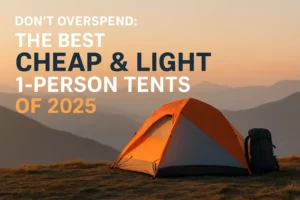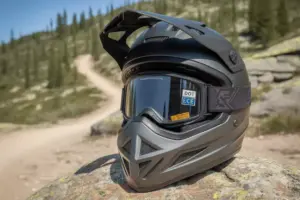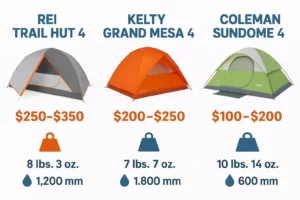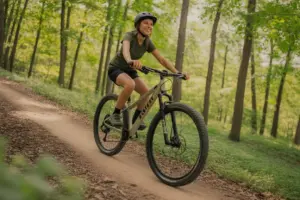Hiking 101: The Beginner’s Guide to Your First Trail
Picture this: You’re standing at the edge of a forest trail, breathing in the crisp mountain air, with nothing but the sound of birds chirping and leaves rustling in the breeze. Your first hiking adventure awaits, promising stunning views, physical challenge, and a deep connection with nature. Yet, as exciting as this moment feels, many beginners find themselves overwhelmed by questions: What gear do I need? How do I choose the right trail? What if I get lost?
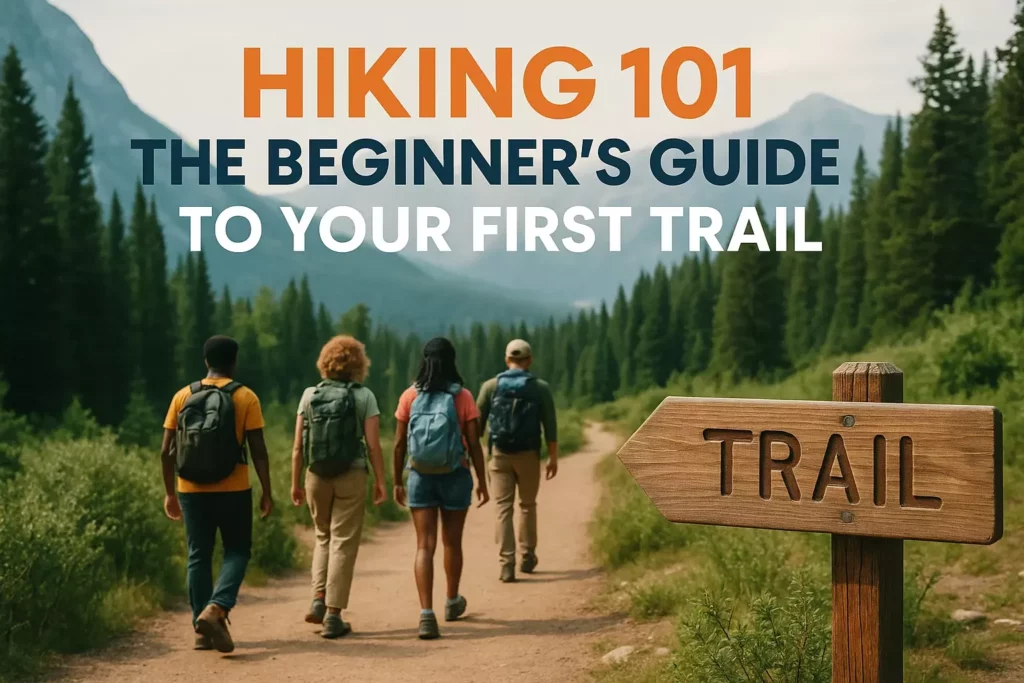
Hiking is one of the most accessible outdoor activities, requiring minimal equipment and offering maximum rewards. Whether you’re seeking a peaceful escape from city life, looking to improve your fitness, or wanting to explore breathtaking landscapes, hiking opens doors to experiences that no gym or indoor activity can match. The best part? Anyone can start hiking, regardless of age or current fitness level.
Key Takeaways
- Start small and build gradually – Choose easy trails under 3 miles for your first few hikes to build confidence and endurance
- Essential gear matters – Proper footwear, layered clothing, and a basic first aid kit can make or break your hiking experience
- Safety comes first – Always inform someone of your plans, carry navigation tools, and know your limits
- Preparation prevents problems – Research your trail, check weather conditions, and pack appropriate supplies
- Leave No Trace – Respect nature by following established principles to preserve trails for future hikers
Understanding Different Types of Hiking Trails
Trail Difficulty Ratings 🥾
Most hiking trails follow a standardized rating system that helps beginners choose appropriate routes:
Easy Trails:
- Distance: 1-3 miles
- Elevation gain: Under 500 feet
- Terrain: Well-maintained paths, minimal obstacles
- Perfect for: First-time hikers, families with children
Moderate Trails:
- Distance: 3-6 miles
- Elevation gain: 500-1,500 feet
- Terrain: Some steep sections, possible rocky areas
- Perfect for: Hikers with basic experience
Difficult Trails:
- Distance: 6+ miles
- Elevation gain: 1,500+ feet
- Terrain: Steep climbs, technical sections, potential hazards
- Perfect for: Experienced hikers only
Types of Hiking Experiences
| Trail Type | Description | Best For |
|---|---|---|
| Day Hikes | Complete round trips in one day | Beginners, weekend warriors |
| Loop Trails | Circular routes with varied scenery | Those who prefer not to backtrack |
| Out-and-Back | Hike to a destination and return the same way | Simple navigation, specific viewpoints |
| Point-to-Point | Start and end at different locations | Advanced planning, shuttle arrangements |
Essential Hiking Gear for Beginners
The Foundation: Proper Footwear
Your feet are your most important hiking tools. Investing in quality hiking boots or shoes is non-negotiable for a safe and comfortable experience.
Hiking Boots vs. Hiking Shoes:
- Boots: Ankle support, better for rough terrain, heavier
- Shoes: Lighter weight, more breathable, suitable for easy trails
Key Features to Look For:
- Non-slip soles with deep treads
- Waterproof or water-resistant materials
- Proper fit with room for toe movement
- Broken-in before your first trail
Clothing Essentials
The layering system is crucial for hiking comfort:
Base Layer: Moisture-wicking materials (avoid cotton)
Insulating Layer: Fleece or down for warmth
Outer Layer: Waterproof/windproof shell
For comprehensive guidance on selecting appropriate outdoor clothing, check out our detailed guide on cool weather clothes for camping, which covers layering principles that apply equally well to hiking.
Must-Have Gear Checklist ✅
Navigation & Safety:
- Map and compass (even with GPS devices)
- First aid kit
- Whistle for emergencies
- Flashlight or headlamp with extra batteries
Comfort & Sustenance:
- Plenty of water (more than you think you need)
- High-energy snacks
- Sun protection (hat, sunglasses, sunscreen)
- Weather-appropriate clothing
Backpack Essentials:
Knowing how to pack your backpack for camping principles applies to day hiking as well. Distribute weight evenly and keep frequently used items easily accessible.
Pro Tip: “The best gear is the gear you know how to use. Practice with your equipment before hitting the trail.” – Experienced Hiking Guide
Planning Your First Hiking Adventure
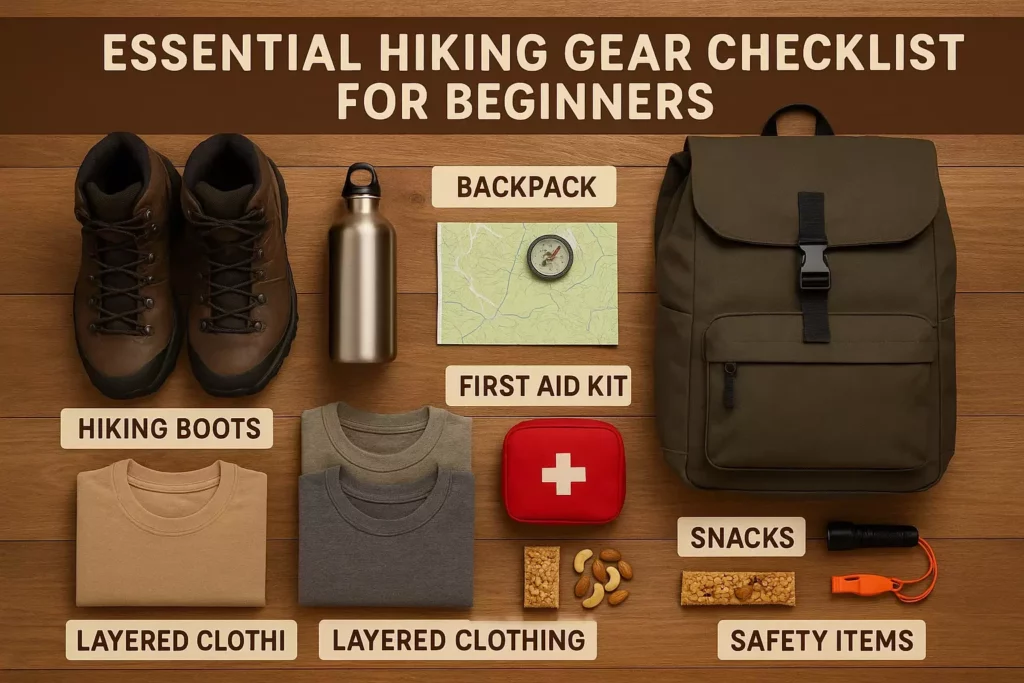
Choosing Your First Trail
Research is everything when selecting your inaugural hiking experience. Consider these factors:
Location Accessibility:
- Choose trails within 1-2 hours of your home
- Look for well-marked trailheads with parking
- Select popular trails with good reviews
Trail Conditions:
- Check recent trail reports online
- Verify seasonal accessibility
- Confirm current weather conditions
Personal Factors:
- Honestly assess your current fitness level
- Consider any physical limitations
- Factor in available time (including travel)
Pre-Hike Preparation
Physical Preparation:
Start building endurance 2-3 weeks before your hike:
- Take daily walks, gradually increasing distance
- Practice walking on uneven surfaces
- Strengthen leg and core muscles
Mental Preparation:
- Set realistic expectations for your first hike
- Plan for rest breaks every 30-45 minutes
- Prepare for the possibility of turning back early
Logistical Planning:
- Inform someone of your hiking plans and expected return
- Download offline maps to your phone
- Check trail permits or fees required
Safety First: Essential Hiking Safety Tips
Before You Leave
The Golden Rules of Hiking Safety:
- Tell Someone Your Plans: Share your intended route, start time, and expected return
- Check Weather Conditions: Avoid hiking in severe weather
- Know Your Limits: Choose trails within your ability level
- Carry Emergency Supplies: Including items for unexpected overnight stays
On the Trail Safety
Navigation Best Practices:
- Stay on marked trails
- Pay attention to trail blazes and markers
- Take photos at trail junctions for reference
- Turn around periodically to see the return route
Wildlife Encounters:
- Make noise while hiking to avoid surprising animals
- Store food properly to avoid attracting wildlife
- Know what to do if you encounter local wildlife species
- Never feed wild animals
Emergency Preparedness:
Having a well-stocked first aid kit is crucial for any outdoor adventure. Learn about building your first aid kit to ensure you’re prepared for common hiking injuries like cuts, sprains, or blisters.
Water Safety and Hydration
Hydration Guidelines:
- Drink water regularly, even if you don’t feel thirsty
- Carry at least 1 liter for every 2 hours of hiking
- Bring water purification tablets for longer hikes
For extended adventures where water sources might be encountered, understanding how to purify water for drinking while camping becomes essential knowledge.
🥾 Trail Difficulty Calculator
What to Expect on Your First Hike
Physical Sensations and Challenges
Normal First-Hike Experiences:
- Elevated heart rate and breathing
- Leg muscle fatigue, especially on inclines
- Increased thirst and appetite
- Possible minor blisters or hot spots
When to Take Breaks:
- Every 30-45 minutes for beginners
- When breathing becomes labored
- At scenic viewpoints (enjoy the journey!)
- When experiencing any discomfort
Mental and Emotional Aspects
Common First-Timer Thoughts:
- “Am I going the right way?”
- “How much farther to the top?”
- “Should I turn back?”
Overcoming Mental Barriers:
Remember that hiking is not a race. Focus on:
- Enjoying your surroundings
- Celebrating small milestones
- Taking photos to capture memories
- Listening to nature sounds
Trail Wisdom: “Mountains don’t care about your timeline. Take your time, be safe, and enjoy every step of the journey.”
Trail Etiquette and Leave No Trace Principles
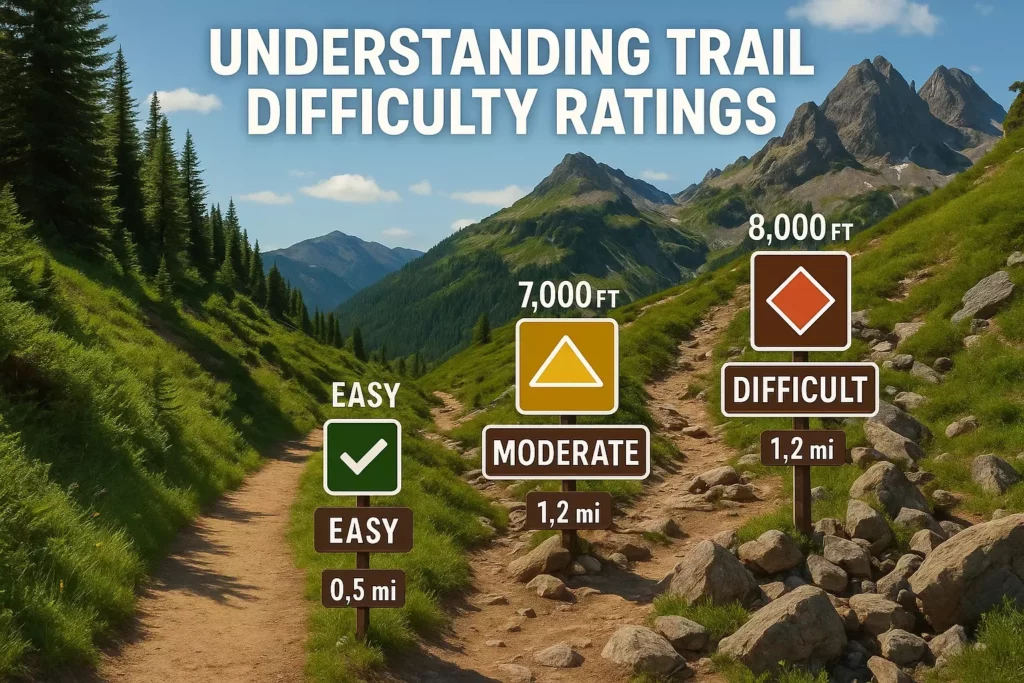
Basic Trail Courtesy
Right of Way Rules:
- Uphill hikers have right of way
- Hikers yield to horses
- Bikers yield to hikers and horses
Noise Considerations:
- Keep voices at conversational levels
- Avoid playing music on speakers
- Be mindful of wildlife and other hikers seeking peace
Leave No Trace Essentials 🌲
The Seven Principles:
- Plan Ahead and Prepare
- Travel and Camp on Durable Surfaces
- Dispose of Waste Properly (pack out all trash)
- Leave What You Find
- Minimize Campfire Impacts
- Respect Wildlife
- Be Considerate of Other Visitors
Practical Applications:
- Stay on designated trails
- Pack out all food scraps and trash
- Don’t pick flowers or disturb natural features
- Keep pets leashed where required
Building Your Hiking Skills and Confidence
Progressive Skill Development
Month 1: Foundation Building
- Complete 3-4 easy trails
- Focus on gear comfort and basic navigation
- Practice packing and unpacking your backpack efficiently
Month 2-3: Expanding Horizons
- Try moderate trails with more elevation
- Practice using map and compass
- Experiment with different hiking snacks and hydration strategies
Month 4+: Advanced Challenges
- Consider longer day hikes
- Learn basic wilderness first aid
- Explore different hiking environments (desert, forest, coastal)
Family Hiking Considerations
If you’re planning to introduce children to hiking, our comprehensive guide on camping with kids and family camping offers valuable insights that apply to day hiking as well. Additionally, check out specific family camping tips and activities for kids to make outdoor adventures engaging for younger family members.
Seasonal Hiking Considerations
Spring Hiking:
- Watch for muddy conditions and stream crossings
- Be prepared for variable weather
- Enjoy wildflowers and wildlife activity
Summer Hiking:
- Start early to avoid heat
- Carry extra water
- Wear sun protection
Fall Hiking:
- Dress in layers for temperature changes
- Be cautious of wet leaves on trails
- Enjoy spectacular foliage
Winter Hiking:
- Requires specialized gear and experience
- Consider starting with snowshoeing
- Always check avalanche conditions in mountainous areas
Advanced Preparation: Gear and Skills
Expanding Your Gear Collection
As you gain experience, consider investing in:
Navigation Tools:
- GPS device or smartphone with offline maps
- Detailed topographic maps
- Quality compass
Comfort Upgrades:
- Trekking poles for stability and joint protection
- Better backpack with proper fit
- Moisture-wicking hiking socks
Safety Equipment:
For those planning to extend their hiking into overnight adventures, understanding bushcraft survival kit essentials for camping provides valuable knowledge about emergency preparedness in wilderness settings.
Weather Preparedness
Reading Weather Signs:
- Dark clouds building = potential storms
- Sudden temperature drops = weather change coming
- Strong winds = possible severe weather
Emergency Weather Protocol:
- Seek shelter immediately during lightning
- Turn back if conditions deteriorate
- Carry emergency shelter (space blanket minimum)
Nutrition and Hydration for Hiking
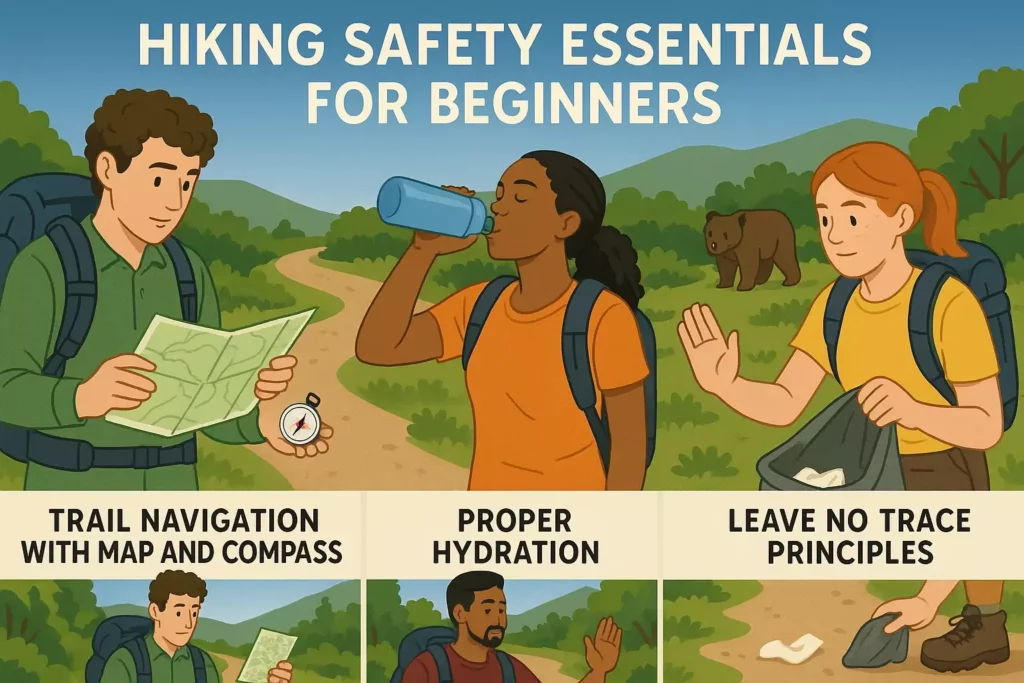
Pre-Hike Nutrition
24 Hours Before:
- Eat balanced meals with complex carbohydrates
- Avoid trying new foods
- Stay well-hydrated
Morning of Hike:
- Eat a substantial breakfast 2-3 hours before starting
- Include protein, carbohydrates, and healthy fats
- Avoid excessive caffeine
On-Trail Nutrition
Ideal Hiking Snacks:
- Trail mix with nuts and dried fruit
- Energy bars (test beforehand)
- Fresh fruit (apples, bananas)
- Jerky or other protein sources
Hydration Strategy:
- Drink small amounts frequently
- Monitor urine color (should be light yellow)
- Consider electrolyte replacement on longer hikes
For extended outdoor adventures, learning about campfire cooking and preparing typical morning meals can enhance your outdoor cooking skills for multi-day hiking trips.
Common Beginner Mistakes to Avoid
Gear-Related Mistakes
Overpacking:
- Carrying unnecessary items adds weight and fatigue
- Stick to essentials for your first few hikes
- Learn from experience what you actually use
Underpacking:
- Forgetting water or snacks
- Not bringing weather protection
- Leaving navigation tools behind
Planning Mistakes
Overambitious Goals:
- Choosing trails too difficult for current ability
- Underestimating time requirements
- Not having backup plans
Poor Timing:
- Starting too late in the day
- Hiking during extreme weather
- Not checking trail conditions
Safety Oversights
Navigation Errors:
- Relying solely on phone GPS
- Not informing others of plans
- Ignoring trail markers
Physical Overexertion:
- Pushing through serious pain
- Not taking adequate breaks
- Ignoring signs of dehydration or exhaustion
Building a Hiking Community
Finding Hiking Partners
Local Resources:
- Hiking clubs and meetup groups
- Outdoor gear stores often host group hikes
- Social media hiking communities
- Friends and family members interested in outdoor activities
Benefits of Group Hiking:
- Increased safety through numbers
- Shared knowledge and experience
- Motivation and encouragement
- Social connections with like-minded people
Solo Hiking Considerations
When You’re Ready for Solo Adventures:
- After completing several group hikes successfully
- When you’re confident with navigation
- After building good physical conditioning
- With proper emergency preparedness
Solo Hiking Safety:
- Always inform someone of your detailed plans
- Carry emergency communication device
- Choose well-traveled trails
- Trust your instincts about conditions and safety
Extending Your Hiking Adventures
From Day Hikes to Overnight Adventures
Once you’ve mastered day hiking, you might consider extending your adventures:
Preparation for Overnight Trips:
Understanding how to pick a sleeping bag for camping becomes essential when transitioning to backpacking. Additionally, learning about tent setup and first-time camp preparation provides foundational skills for overnight outdoor adventures.
Skills to Develop:
- Campsite selection and setup
- Backcountry cooking
- Advanced navigation
- Leave No Trace camping principles
Specialized Hiking Types
Peak Bagging:
- Hiking specifically to reach mountain summits
- Requires advanced planning and skills
- Often involves longer, more challenging routes
Photography Hiking:
- Combining hiking with landscape photography
- May involve carrying additional gear
- Often requires patience and different timing
Nature Study Hiking:
- Focus on flora, fauna, and geology
- Slower pace with frequent stops
- Educational and meditative approach
Conclusion
Embarking on your first hiking adventure marks the beginning of a lifelong journey filled with natural beauty, physical challenge, and personal growth. The most important step is simply taking that first step onto the trail. Remember that every experienced hiker was once a beginner, facing the same uncertainties and excitement that you feel now.
Start with easy, well-marked trails close to home, invest in proper footwear and basic safety gear, and always prioritize safety over ambition. Focus on building your skills gradually, learning from each experience, and developing confidence in your abilities. The trails will always be there, ready for you to explore them at your own pace.
Your Next Steps:
- Choose your first trail using the guidelines provided in this guide
- Gather essential gear starting with proper footwear and basic safety items
- Plan your first hike including route research and weather checking
- Inform someone of your hiking plans and expected return time
- Hit the trail and enjoy every moment of your outdoor adventure
The hiking community welcomes newcomers with open arms, and nature offers lessons that no classroom can teach. Whether you’re seeking physical fitness, mental clarity, stress relief, or simply a new way to spend your weekends, hiking provides all of these benefits and more.
Remember, the goal isn’t to conquer mountains on your first day – it’s to develop a sustainable, enjoyable relationship with the outdoors that will enrich your life for years to come. Every trail offers something different, every hike teaches new lessons, and every step forward builds the foundation for bigger adventures ahead.
So lace up those hiking boots, shoulder your pack, and step into the natural world that’s waiting just beyond the trailhead. Your hiking journey starts now, and the best view comes after the hardest climb – but even the easiest trails offer rewards beyond measure.

